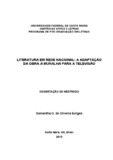| dc.creator | Borges, Samantha de Oliveira | |
| dc.date.accessioned | 2013-10-21 | |
| dc.date.available | 2013-10-21 | |
| dc.date.issued | 2013-03-01 | |
| dc.identifier.citation | Borges, Samantha de Oliveira. Literature on national network: the adaptation of the book A Muralha to the television. 2013. 116 f. Dissertação (Mestrado em Letras) - Universidade Federal de Santa Maria, Santa Maria, 2013. | por |
| dc.identifier.uri | http://repositorio.ufsm.br/handle/1/9887 | |
| dc.description.abstract | This paper presents the analysis of the adaptation process of the book A
Muralha, from author Dinah Silveira de Queiroz, to the miniseries format, written by
Maria Adelaide Amaral. The literary narrative was ordered to Dinah as a tribute to
400 years anniversary of the city of São Paulo, which was in the year of 1954. The
miniseries was broadcasted by Rede Globo de Televisão, in the year 2000,
celebrating the 500 years of Brazil s discovery. A classical historical novel, the
narrative performs a recall of the Paulista capital foundation time and its first
pioneers, the bandeirantes. In order to understand the television transposition,
initially we perform a theoretical revision that includes since the fundamentals of
comparative literature until we get to the intermediality theory, also highlighting the
way crossed by the adaptation since its cinematographic version until its television
variety. The goal of this research is to analyze the adaptation starting with the
elements listed by Robert Stam (2003): authorship, characters, exchanges and
history and context modifications. Moreover, Stam grounds his methodological model
in dialogism theories from Mikhail Bakhtin revisited by Julia Kristeva and in
transtextuality by Gérard Genette, also used to justify the analysis. When we
describe and analyze the textual elements that are modified, transformed, excluded
or enlarged at the adaptive process of the literary narrative to the televisual narrative,
we pick out, among the analysis elements, the hipertextuality that, according to
Genette (2006), consists of every relationship that unites a text B (hypertext) to a
previous text A (hypotext). At A Muralha adaptation, the literary work consists of a
hypotext and the miniseries, a hypertext. In this light, the hypertextual narrative
(miniseries) enlarges, modifies, transforms and recreates the textual characters,
thematic, plots and times of the hypotextual narrative (book). From this, it is
concluded that the adaptive process is set as a space of dialogue between the
literature and other Medias, promoting different rereadings of the same narrative and
stimulating the intermediatic capacity of the texts studied. | eng |
| dc.description.sponsorship | Coordenação de Aperfeiçoamento de Pessoal de Nível Superior | |
| dc.format | application/pdf | por |
| dc.language | por | por |
| dc.publisher | Universidade Federal de Santa Maria | por |
| dc.rights | Acesso Aberto | por |
| dc.subject | Literatura | por |
| dc.subject | Mídia | por |
| dc.subject | Adaptação | por |
| dc.subject | Intermidialidade | por |
| dc.subject | Hipertextualidade | por |
| dc.subject | Literature | eng |
| dc.subject | Media | eng |
| dc.subject | Adaptation | eng |
| dc.subject | Intermediality | eng |
| dc.subject | Hypertextuality | eng |
| dc.title | Literatura em rede nacional: a adaptação da obra A Muralha para a televisão | por |
| dc.title.alternative | Literature on national network: the adaptation of the book A Muralha to the television | eng |
| dc.type | Dissertação | por |
| dc.description.resumo | Este trabalho apresenta a análise do processo de adaptação da obra A
Muralha, de autoria de Dinah Silveira de Queiroz, para o formato minissérie, escrita
por Maria Adelaide Amaral. A narrativa literária foi encomendada à Dinah em
homenagem ao aniversário de 400 anos da cidade de São Paulo, ocorrido no ano de
1954. Já a minissérie foi transmitida pela Rede Globo de Televisão, no ano 2000, em
comemoração aos 500 anos de descobrimento do Brasil. Romance histórico
clássico, a narrativa realiza um resgate do período de fundação da capital paulista e
de seus primeiros desbravadores, os bandeirantes. Para compreender a
transposição televisiva, inicialmente é realizada uma revisão teórica que abrange
desde os fundamentos da literatura comparada até chegar à teoria da
intermidialidade, além de se ressaltar o caminho percorrido pela adaptação desde
sua versão cinematográfica até sua variante televisiva. O objetivo da pesquisa é
analisar a adaptação a partir de elementos elencados por Robert Stam (2006):
autoria, personagens, permutas e modificações da história e contexto. Além disso,
Stam baseia seu modelo metodológico nas teorias do dialogismo de Mikhail Bakhtin
revisitado por Julia Kristeva - e da transtextualidade de Gérard Genette, que
também são utilizadas para fundamentar a análise. Ao visar descrever e analisar
elementos textuais que são modificados, transformados, excluídos ou ampliados no
processo adaptativo da narrativa literária para a narrativa televisual destaca-se,
entre os elementos de análise, a hipertextualidade que segundo Genette (2006)
consiste em toda relação que une um texto B (hipertexto) a um texto anterior A
(hipotexto). Na adaptação de A Muralha a obra literária constitui-se em um hipotexto
e a minissérie em um hipertexto. Sob esse prisma, a narrativa hipertextual
(minissérie) amplia, modifica, transforma e recria personagens, temáticas, enredos e
tempos textuais da narrativa hipotextual (livro). Conclui-se a partir disso, que o
processo adaptativo se configura em um espaço de diálogo entre a literatura e
outras mídias, promovendo diferentes releituras de uma mesma narrativa e
estimulando a capacidade intermidiática dos textos trabalhados. | por |
| dc.contributor.advisor1 | Umbach, Rosani Úrsula Ketzer | |
| dc.contributor.advisor1Lattes | http://lattes.cnpq.br/5773862679226891 | por |
| dc.contributor.referee1 | Londero, Rodolfo Rorato | |
| dc.contributor.referee2 | Vieira, Andre Soares | |
| dc.contributor.referee2Lattes | http://lattes.cnpq.br/9443094274110873 | por |
| dc.creator.Lattes | http://lattes.cnpq.br/3992791677044673 | por |
| dc.publisher.country | BR | por |
| dc.publisher.department | Letras | por |
| dc.publisher.initials | UFSM | por |
| dc.publisher.program | Programa de Pós-Graduação em Letras | por |
| dc.subject.cnpq | CNPQ::LINGUISTICA, LETRAS E ARTES::LETRAS | por |


